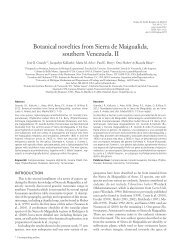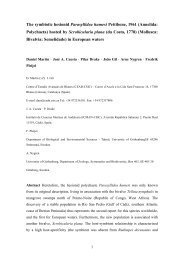PhD Thesis MJProl .pdf - digital-csic Digital CSIC - Consejo Superior ...
PhD Thesis MJProl .pdf - digital-csic Digital CSIC - Consejo Superior ...
PhD Thesis MJProl .pdf - digital-csic Digital CSIC - Consejo Superior ...
You also want an ePaper? Increase the reach of your titles
YUMPU automatically turns print PDFs into web optimized ePapers that Google loves.
New strategies for the control of bacterial infections in marine fish larval rearing 19<br />
Table 1.2. The immunostimulants used in fish larval aquaculture.<br />
Immunostimulant Species Effect Reference<br />
Alginate Turbot (Psetta maxima)<br />
Cod milt proteins<br />
β-1,3/β-1,6 glucans<br />
β-glucans and mannanoligosaccharides<br />
Lipopolysaccharide<br />
Atlantic cod<br />
(Gadus morhua)<br />
Atlantic cod<br />
(Gadus morhua)<br />
Common dentex<br />
(Dentex dentex)<br />
Chilean flounder<br />
(Paralichthys adspersus)<br />
Atlantic cod<br />
(Gadus morhua)<br />
Sea bream<br />
(Sparus aurata)<br />
Survival improvement<br />
and growth increase<br />
Conceicão et al. (2004)<br />
Survival improvement Pedersen et al. (2004)<br />
Survival improvement<br />
and growth increase<br />
Survival improvement<br />
and growth increase<br />
Survival improvement<br />
and growth increase<br />
1.3. Strategies based on the food chain<br />
Survival improvement<br />
Skjermo et al. (2006)<br />
Efthimiou (1996)<br />
Piaget et al. (2007)<br />
Magnadottir et al.<br />
(2006)<br />
Survival improvement Hanif et al. (2005)<br />
Large scale use of probiotics in the rearing of marine fish larvae involves<br />
cultivation of bacteria in artificial medium, preparation of a stable form of these bacteria<br />
and development of a process for the transfer of probiotics to the larval gut either by<br />
direct addition to seawater in the rearing tanks or by bioencapsulation in live feed. The<br />
approach of addition of bacteria to the seawater is simpler but implicates that the added<br />
bacteria remain in the seawater column for some time to be filtered by rotifers or<br />
Artemia and thereby to be introduced in the larval gut. A far more efficient approach is<br />
the bioencapsulation of bacteria in live feed. This is the only possible route in the case<br />
of allochthonous bacteria of tellurian origin tested in larviculture, such as lactic acid<br />
bacteria and Bacillus strains (Gatesoupe, 1994). These bacteria are not normally<br />
encountered in marine systems, but when introduced in larvae may have positive effects<br />
for the larvae by excreting antimicrobial compounds or by other ways limiting the<br />
growth of harmful bacteria.<br />
Bioencapsulation of bacteria is a relatively predictable process in the case of<br />
rotifers but more variable in the case of Artemia metanauplii, as the size of bacteria may<br />
prove decisive for the efficiency of the process (Makridis et al., 2000). Artemia<br />
metanauplii have a filtering device which enables them to filter large bacterial cells or

















